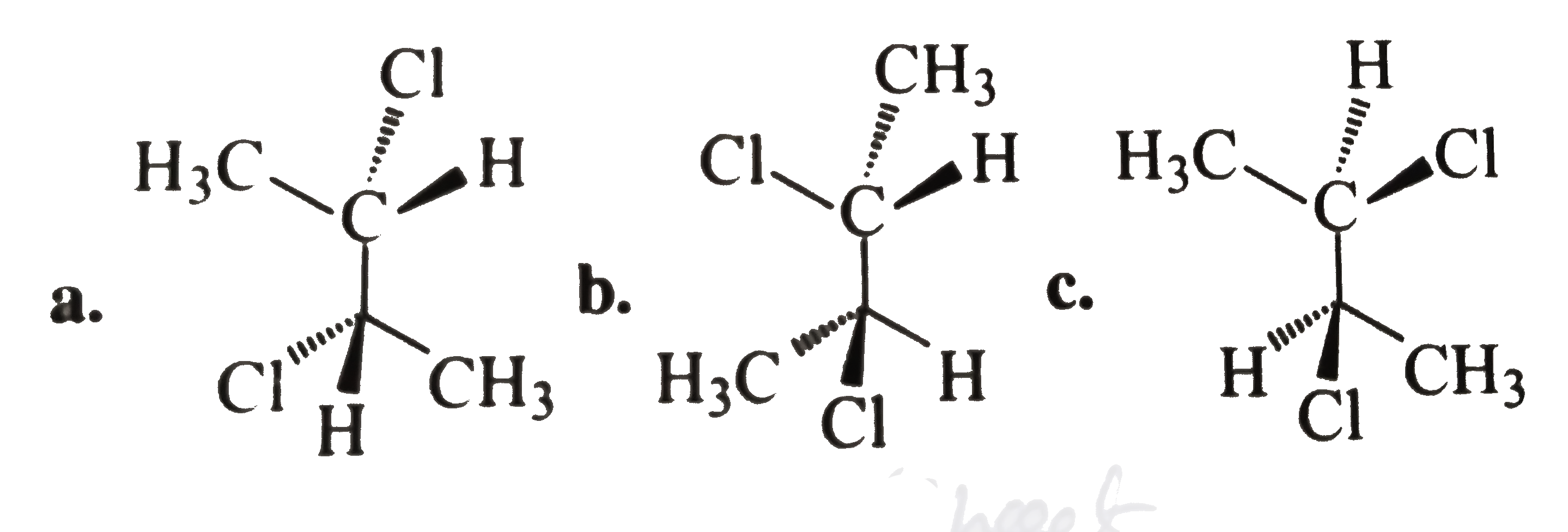The compound 2,3- dichlorobutane exhibits
Diastereomerism
Optical
Geometrical
Structural
To determine the type of isomerism exhibited by 2,3-dichlorobutane, we will analyze its structure and the characteristics of various types of isomerism.
Step 1: Understand the Structure of 2,3-Dichlorobutane
2,3-Dichlorobutane is a four-carbon alkane with chlorine atoms attached to the second and third carbon atoms. The structural formula can be represented as follows:
CH3−CH(Cl)−CH(Cl)−CH3
Step 2: Identify Chiral Centers
A compound exhibits optical isomerism if it has chiral centers. A chiral center is a carbon atom that is bonded to four different substituents. In 2,3-dichlorobutane, the second and third carbon atoms (C2 and C3) are each bonded to four different groups:
- C2: CH3, Cl, H, and the carbon chain (C3)
- C3: CH3, Cl, H, and the carbon chain (C2)
Since both C2 and C3 are chiral centers, 2,3-dichlorobutane can exhibit optical isomerism.
Step 3: Determine if Optical Isomerism Exists
Optical isomers are non-superimposable mirror images of each other. Since 2,3-dichlorobutane has two chiral centers, it can form multiple stereoisomers. Specifically, it can form 2^n stereoisomers, where n is the number of chiral centers. Here, n = 2, so:
\( 2^2 = 4 \text{ optical isomers} \)
Step 4: Check for Diastereoisomerism
Diastereoisomers are stereoisomers that are not mirror images of each other. Since 2,3-dichlorobutane has two chiral centers, it can have diastereoisomers. The presence of two chiral centers means that there are stereoisomers that are not mirror images, confirming that diastereoisomerism is also exhibited.
Step 5: Evaluate Other Types of Isomerism
- Geometrical Isomerism: This type of isomerism occurs due to restricted rotation around a double bond or a ring structure. Since 2,3-dichlorobutane does not have a double bond, it does not exhibit geometrical isomerism.
- Structural Isomerism: This occurs when compounds have the same molecular formula but different structural arrangements. 2,3-Dichlorobutane does not exhibit structural isomerism as it has a specific structure.
Conclusion
Based on the analysis, 2,3-dichlorobutane exhibits optical isomerism and diastereoisomerism but does not exhibit geometrical or structural isomerism.
Final Answer
2,3-Dichlorobutane exhibits optical isomerism.
---
2,3-Dichlorobutane is a four-carbon alkane with chlorine atoms attached to the second and third carbon atoms. The structural formula can be represented as follows:
A compound exhibits optical isomerism if it has chiral centers. A chiral center is a carbon atom that is bonded to four different substituents. In 2,3-dichlorobutane, the second and third carbon atoms (C2 and C3) are each bonded to four different groups:
- C3: CH3, Cl, H, and the carbon chain (C2)
Optical isomers are non-superimposable mirror images of each other. Since 2,3-dichlorobutane has two chiral centers, it can form multiple stereoisomers. Specifically, it can form 2^n stereoisomers, where n is the number of chiral centers. Here, n = 2, so:
Diastereoisomers are stereoisomers that are not mirror images of each other. Since 2,3-dichlorobutane has two chiral centers, it can have diastereoisomers. The presence of two chiral centers means that there are stereoisomers that are not mirror images, confirming that diastereoisomerism is also exhibited.
- Geometrical Isomerism: This type of isomerism occurs due to restricted rotation around a double bond or a ring structure. Since 2,3-dichlorobutane does not have a double bond, it does not exhibit geometrical isomerism.
- Structural Isomerism: This occurs when compounds have the same molecular formula but different structural arrangements. 2,3-Dichlorobutane does not exhibit structural isomerism as it has a specific structure.
Based on the analysis, 2,3-dichlorobutane exhibits optical isomerism and diastereoisomerism but does not exhibit geometrical or structural isomerism.
2,3-Dichlorobutane exhibits optical isomerism.
Topper's Solved these Questions
- INTRODUCTION TO ORGANIC CHEMISTRY BOOK - VMC MODULES ENGLISHCHAPTER - INTRODUCTION TO ORGANIC CHEMISTRY EXERCISE - JEE ADVANCED ARCHIVE
81 Videos
- INTRODUCTION TO ORGANIC CHEMISTRY BOOK - VMC MODULES ENGLISHCHAPTER - INTRODUCTION TO ORGANIC CHEMISTRY EXERCISE - LEVEL 2 (Numerical value type )
15 Videos
- ICONIC EQUILIBRIUMBOOK - VMC MODULES ENGLISHCHAPTER - ICONIC EQUILIBRIUMEXERCISE - IMPECCABLE
50 Videos
- IONIC EQUILIBRIUMBOOK - VMC MODULES ENGLISHCHAPTER - IONIC EQUILIBRIUMEXERCISE - IN - CHAPTER EXERCISE - K
10 Videos
Similar Questions
Knowledge Check
The compound which does not exhibit optical isomerism is
ACH3CHBrCOOHBCH2ClCH2COOHCCH3CHOHCOOC2H5DCH3CHOHCOOHThe compound which exhibits linkage isomerism is :
A[Cr(NH3)6]3+B[Co(NH3)6]3+C[Co(NH3)5NO2]Cl2D[Pt(NH3)2Cl2]The compound which may exhibit tautomerism:
A B
B C
C DAll of these
DAll of these
Give the names and formulae of the compounds in which sulphur exhibits an oxidation state of
(A)−2 , (B)+4 , ( C)+6
View SolutionIn which of the following compounds, carbon exhibits a valency of
four but oxidation state of -2 ?
View SolutionIn which of the compounds oxygen does not exhibit oxidation state (-2)?
View SolutionThe compound (s) the exhibit(s) geometrical isomerism is (are ) :
View SolutionIn which of the following compounds,nitrogen exhibits highest oxidation state?
View Solution

